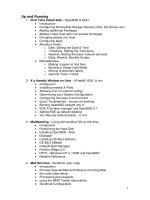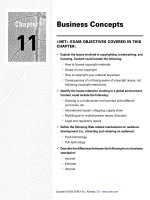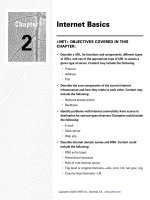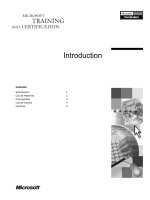Tài liệu Answer Key pdf
Bạn đang xem bản rút gọn của tài liệu. Xem và tải ngay bản đầy đủ của tài liệu tại đây (93.28 KB, 26 trang )
1
○○○○○○○○○○○○○○○○○○○○○○○○○○○○○○○○○○○○○○○○○○○○○○○○
Answer Key
12
1. a, d
2. b
3. b, c
4. b
5. b
6. e
7. b
8. b
9. d
10. c
11. b
12. b
13. d
14. a
15. c
16. c
17. b
18. c, d
19. a
20. a, b, c
21. d
22. b
23. d
24. b
25. b
26. e
27. d
28. c
29. d
30. c
31. c
32. d
33. e
34. b, c, d
35. c
36. b
37. a
38. d
39. a
40. d
41. d
42. c
43. a
44. c
45. b
46. d
47. c
48. b
49. b
50. a, d
51. a, b
52. c
53. c
54. c
55. b, c, d, f
56. e
57. b
58. a
59. c
60. e
61. b
62. a, b, c
63. f
64. c, d
65. e
66. a, b, d
67. e
68. c
69. a
70. a, c, e
71. d
72. d
73. c
74. d
75. c
76. d
77. d
78. c
79. a
80. e
81. a, b, c, d, f, h, j
82. b
83. b, d
84. a
85. b, d, e
86. d
87. a
88. a
89. e
90. d
91. c
92. a
93. a
94. b, c
95. a, c, d
96. a, c, d
97. b, d
98. a
99. b
100. d
2
○○○○○○○○○○○○○○○○○○○○○○○○○○○○○○○○○○○○○○○○
Chapter 12
Question 1
The correct answers are a and d. Layer 2 (Data Link layer) handles frames across
the physical medium. Answer b is incorrect, because bits are transferred at layer 1
(Physical layer) of the OSI model. Answer c is incorrect, because layer 3 (Net-
work layer) is commonly known as packets.
Question 2
The correct answer is b. To enable RIP routing, you issue the router rip global
command. By default, a Cisco router will send only RIP version I packets but will
listen for RIP I and RIP II. Therefore, if you only configure RIP I, then RIP II
packets will also be received and placed in the routing table, but they will not be
advertised by RIP. If you enable RIP II with the version 2 command, then you’ll
only send and receive RIP II packets. Answer a is incorrect, because router-rip is
an invalid IOS command. Answer c is incorrect, because the version 2 command
is only applicable to the interface and does not satisfy the question. Answer d is
incorrect, because ip rip version 2 is an invalid IOS command. Answer e is incor-
rect, because answer a is an invalid IOS command.
Question 3
The correct answers are b and c. The unique bridge identifier is made up of the
bridge’s MAC address and the priority, which is either set by the administrator or
is a default value. Answer a is incorrect, because the IP address (layer 3 or the
Network layer) is not part of the spanning tree protocol or the bridge identifier.
Answer d is incorrect, because the cost is used between switches and is not part of
the unique bridge identifier.
Question 4
The correct answer is b. The Simple Server Redundancy Protocol (SSRP) creates
fault tolerance using standard LANE protocols and mechanisms. Typically, SSRP
is implemented in large ATM LANE environments. Answer a is incorrect, be-
cause Ethernet is defined in 802.3 and not by LANE. Answer c is incorrect,
because Token Ring is defined in 802.5 and not by LANE. Answer d is incorrect,
because answers a and c are incorrect.
Question 5
The correct answer is b. When a SNAP header is found (DSAP [Destination
Service Access Point] and SSAP [Source Service Access Point] fields in the frame
are set to AA AA, respectively) this tells the device to look further into the data
for the type of payload being sent. SSAP/DSAP is used to the destination, plus
3
○○○○○○○○○○○○○○○○○○○○○○○○○○○○○○○○○○○○○○○○
Answer Key
they define the recipient of a packet. Answer a is incorrect, because the routing
information field is indicated by the first bit in the source address. Answer c is
incorrect, because the DSAP/SSAP fields are not used to detect collisions. An-
swer d is incorrect, because the address copied and the recognized fields are part
of the frame status field in a Token Ring data frame, which are found further
down the frame, after the SNAP header.
Question 6
The correct answer is e. The address recognized (A) bit and the address copied
(C) bit are duplicated to ensure the integrity of the two fields. The A and C bits
are not checked by the frame check sequence fields because only the FC, DA,
SA, and data fields are checked. Answer a is incorrect, because the A/C bits are
present in a Token Ring data frame. Answer b is incorrect, because the A/C fields
are not always 1, except when the address was recognized and the frame was
copied. Answer c is incorrect, because the A/C fields are duplicated to ensure
frame integrity. Answer d is incorrect, because the A/C fields are present in To-
ken Ring data frames.
Question 7
The correct answer is b. When a user tries to authenticate to a RADIUS server,
there are three valid responses. They are Accept (user has an authorized account),
Reject (user is not authorized), and Challenge (additional information is required).
Answer b is not a valid response, because ARP (Address Resolution Protocol) is
not part of the RADIUS authentication protocol.
Question 8
The correct answer is b. The default update interval is 90 seconds, and the maxi-
mum hop count for IGRP is 255 (although the default is 100 hops). Answers a,
c, and d are incorrect, because as they represent wrong update intervals and hop
counts. Hop count is not used as a metric; it is used to determine route integrity.
Question 9
The correct answer is d. Any single IGRP update can advertise a total of 104
networks. Answers a, b, c, and e are incorrect, because 104 is the correct answer.
Question 10
The correct answer is c. OSPF requires a valid IP address to be allocated to the
router id. The router id is sent in all updates and in the discovery of new routers.
4
○○○○○○○○○○○○○○○○○○○○○○○○○○○○○○○○○○○○○○○○
Chapter 12
Answer a is incorrect, because, without a router id, OSPF will not start on a Cisco
router. Answer b is incorrect, because the error message is not related to memory
requirements. Answer d is incorrect, because answers a and b are incorrect.
Question 11
The correct answer is b. When RSRB is configured on Cisco routers, the RIF is
not terminated at the local router. The RIF will be composed of every device that
needs to be traversed. The virtual ring on Device A is 10, or 0x00A in hex. On
Device B, the virtual ring is 0x010. Hence, the RIF will be,
0A10.0011.00A1.0101.0020 (that is, through ring 001, bridge 1, ring 00A, bridge
1, ring 010, bridge 1, and finally to the destination ring 002, bridge 0). A RIF
always ends with 0 to identify the destination ring. Therefore, answers a and c are
immediately discounted. Answer d is incorrect because in a RSRB environment
the RIF is used to determine the path to remote SRB devices.
Question 12
The correct answer is b. The 0.0.0.0 255.255.255.255 parameter is shorthand for
the any keyword. This means we are not concerned about hosts or which net-
works are to be passed to the IP routing software. Answer a is incorrect, because
the dash is missing between the access and list keywords. Answer c is incorrect,
because the IOS will display the wildcard address 0.0.0.0 255.255.255.255 as
any. Answer d is incorrect, because the question provides enough IOS code to
determine that answer b is the correct answer.
Question 13
The correct answer is d. The IOS syntax is ip policy route-map <name>. The
route-map name is case sensitive. Answer a is incorrect, because the question
contains enough data to determine the correct answer. Answer b is incorrect,
because the IOS syntax is missing route-. Answer c is incorrect, because the
command uses the wrong case—cisco is incorrectly used in place of Cisco.
Question 14
The correct answer is a. RTMP, a distance-vector protocol, sends full broadcasts
every 10 seconds. Answers b, c, and d are incorrect, because the answers state the
wrong broadcast intervals.
5
○○○○○○○○○○○○○○○○○○○○○○○○○○○○○○○○○○○○○○○○
Answer Key
Question 15
The correct answer is c. In a BGP table, any network displayed with a next hop
address of 0.0.0.0 indicates that the network is a local interface. The next hop
address of 131.108.1.2 describes the remote 10.1.2.0/24. Answers a and b are
incorrect, because BGP networks are indicated by a valid next hop address and
not the address 0.0.0.0. Answer d is incorrect, because the question provides
enough data to deduce that answer c is correct.
Question 16
The correct answer is c. To start AppleTalk EIGRP, the correct syntax is appletalk
routing eigrp <router-id>. The router-id must be unique to each router. Answer
a is incorrect, because the appletalk routing command starts RTMP, not EIGRP.
Answer b is incorrect, because the syntax is wrong—no dash is required between
eigrp and the process ID. Answer d is incorrect, because the no appletalk proto-
col RTMP command is used to stop RTMP updates after AppleTalk EIGRP is
enabled.
Question 17
The correct answer is b. In a DECnet environment, such as Ethernet, the DR
helps end nodes find other devices. The priority is used by default, but if two or
more routers have the same priority, the node with the highest node address
becomes the DR. In this case, 1.2 is higher than 1.1, so the router with address
1.2 will become the DR. Answer a is incorrect, because 1.1 is lower than 1.2.
Answer c is incorrect, because a DR is required on a DECnet broadcast network.
Answer d is incorrect, because the question provides enough data to deduce that
answer b is correct.
Question 18
The correct answers are c and d. IP and AppleTalk (AARP) use ARP. Answers a
and b are incorrect, because DECnet and IPX do not use ARP. IPX and DECnet
both use their own MAC address as part of the network address.
Question 19
The correct answer is a. PC-A resides on a Token Ring network and PC-C re-
sides on a Ethernet network. Ethernet devices do not use RIFs, so PC-C cannot
see the RIF frame. Therefore, answers b, c and d are incorrect because they are
examples of RIFs.
6
○○○○○○○○○○○○○○○○○○○○○○○○○○○○○○○○○○○○○○○○
Chapter 12
Question 20
The correct answers are a, b, and c. RIP uses split horizon, hold downs, and
poison reverse to help speed up RIP convergence. Answer d is incorrect, because
IP RIP does not deploy the hello protocol. Instead, because RIP is a distance-
vector protocol, it sends the full contents of its routing table to all neighboring
routers.
Question 21
The correct answer is d. CHAP and PAP are authentication protocols used in
Point-To-Point (PPP) networks. CHAP and PAP ensure that the correct devices
gain access to a network. Answers a, b, c, and e are incorrect, because frame relay,
HDLC, ATM, and LANE do not use CHAP or PAP authentication techniques.
Question 22
The correct answer is b. When redistributing from one IP routing protocol to
another, the network administrator must convert metrics used from one domain
to the other. For example cost in OSPF to hop count in RIP, and vice versa.
Answer a, is incorrect, because RIP must be advised about the metric to be ap-
plied when redistributing OSPF to RIP. Answer c is incorrect, because the OSPF
process id is only locally significant to a Cisco router. Answer d is incorrect,
because OSPF or BGP can be used to route information from a RIP domain.
Question 23
The correct answer is d. The router named Simon has two IP addresses in Area
100 and, therefore, requires the network statements for the two IP addresses only.
To place the directly attached networks into Area 6, two network statements are
required:
network 131.108.1.0 0.0.0.255 area 6
network 131.108.2.0 0.0.0.255 area 6
Answer a is incorrect, because the network 131.108.3.0/24 is not directly at-
tached to the Simon router. Answer b is incorrect, because the network statement
131.108.0.0 0.0.255.255 will place the whole class B range 131.108.0.0 to
131.108.255.255 in area 6. Answer c is incorrect, because the network statements
configured are using the subnet address and not the interface address. The com-
mand 131.108.1.0 0.0.0.0 (subnet address is reserved) will not identify what in-
terface to place under the OSPF process.
7
○○○○○○○○○○○○○○○○○○○○○○○○○○○○○○○○○○○○○○○○
Answer Key
Question 24
The correct answer is b. The access list 100 has not been defined, although the
configuration displays the ip access-group 100 in interface command. When an
access list is not defined, the router will not perform any IP-based filtering. An-
swer a is incorrect, because access list 100 is not defined. Answer c is incorrect,
because serial0 is configured for IP. Answer d is incorrect, because access 100 is
not defined in the global configuration.
Question 25
The correct answer is b. IEEE 802.2 defines the Logical Link Control. Answer a
is incorrect, because Ethernet is defined in IEEE 802.3. Answer c is incorrect,
because Token Ring bus is defined in IEEE 802.4. Answer d is incorrect, because
Token Ring star is defined in IEEE 802.5.
Question 26
The correct answer is e. To copy files from the startup (or NVRAM) configura-
tion to a TFTP server, use the copy startup-config tftp command. Answer a is
incorrect, because the copy tftp running-config command copies a configuration
from a TFTP server to the running configuration. Answers b and c are incorrect,
because the commands are invalid IOS commands. Answer d is incorrect, be-
cause config is not a valid IOS command.
Question 27
The correct answer is d. Ethernet II specifies a type field, and Ethernet 802.3
specifies a length field. Answer a is incorrect, because Ethernet II was released
and Ethernet 802.3 was released in the 1980s. Answer b is incorrect, because
Ethernet 802.3I does not specify the protocol field but the length field following
the source MAC address field. Answer c is incorrect, because Ethernet II speci-
fies a type field, not a length field. Answer e is incorrect, because there is a small
difference between Ethernet II and Ethernet 802.3, even though both versions
of Ethernet transmit in non-canonical order (least significant bit first).
Question 28
The correct answer is c. Bootlfash is used to store IOS images. When an IOS
image is deleted from bootflash (such as a pcmcia flash card) the command squeeze
devicename must be issued to delete the file from the bootflash. Answers a is
incorrect, because reloading the router will have no effect on the bootflash. An-
swer b is incorrect, because you cannot shutdown the bootflash device. Answer d
is incorrect, because this is not a known bug.
8
○○○○○○○○○○○○○○○○○○○○○○○○○○○○○○○○○○○○○○○○
Chapter 12
Question 29
The correct answer is d. When a change is made on a Cisco router’s interface to
change an IP address, the effect is immediate. Answer a is incorrect, because the
command goes into effect immediately—not after exiting the global configura-
tion mode. Answer b is incorrect, because changing the IP address does not re-
quire a router reload. Answer c is incorrect, because you do not need to shut
down the interface when changing the IP address.
Question 30
The correct answer is c. When you intercept a router reload by hitting control
break, you cause the router to enter ROM mode. ROM mode allows you to
determine hardware or software issues. Answer a is incorrect, because, after 60
seconds, the break command has no effect unless specifically configured on the
boot register. Answer b is incorrect, because a break sequence will not cause a
router to enter global configuration mode. Answer d is incorrect, because there is
no engineering mode available to end users. Answer e is incorrect, because the
router will boot into ROM mode when a break key is issued before 60 seconds
when a router reloads.
Question 31
The correct answer is c. Class C addresses, which have only 8 bits, provide the
least number of host devices (254). Answer a is incorrect, because there are more
than 16 million host addresses available with a class A address. Answer b is in-
correct, because a class B address allows more than 16,000 host addresses. An-
swers d and e are incorrect, because class D and class E addresses are reserved.
Question 32
The correct answer is d. The IP checksum only checks for errors in the IP header.
Answers a and b are in incorrect, because the checksum does not involve a packet’s
data portion. Higher layers, such as TCP, check a packet’s data portion. Answer c
is incorrect, because the IP header checksum is not calculated on the whole IP
packet. Answer e is incorrect, because only answer b provides the correct re-
sponse to the question.
Question 33
The correct answer is e. The mask 255.255.255.0 allows for 8 bits to be used by
end devices. Two host addresses (00000000 and 11111111) are reserved for broad-
casts, so you can have up to 2
8
-2=256-2=254 host addresses. Answers a, b, c, and
d are incorrect, because the correct answer is 254 hosts.
9
○○○○○○○○○○○○○○○○○○○○○○○○○○○○○○○○○○○○○○○○
Answer Key
Question 34
The correct answers are b, c, and d. Manual configuration or static routing can
route IP. IP can also be routed using the IS-IS and OSPF routing protocols.
Answer a is incorrect, because IPX RIP is used to route the desktop protocol IPX
and not IP. Answer e is incorrect because RTMP is used for AppleTalk.
Question 35
The correct answer is c. The line that indicates the bandwidth of the interface in
the question is:
MTU 4464 bytes, BW 4000 Kbit, ...
The BW represents the bandwidth in Kbit—4000Kbit in this example. Answers
a, b, d, e, and f are incorrect, because 4 is the correct response.
Question 36
The correct answer is b. An IP routing table or routing information base never
lists layer 2 MAC address information, because a routing table is based on layer 3
information. Answers a, c, and d are incorrect, because IP routing tables list char-
acteristics such as next hop addresses, routing metrics, and outbound interfaces.
Question 37
The correct answer is a. ATM LANE is used to allow protocols such as Ethernet
and Token Ring the high bandwidth that ATM can offer. ATM LANE consists
of the following devices:
➤ LAN Emulation Client (LEC)—Implements the LANE standard including
data forwarding, address resolution (LE-ARP). Each LEC is made up of a
unique ATM address.
➤ LAN Emulation Server (LES)—Manages stations that make up the emulated
LAN
➤ Broadcast and Unknown Server (BUS)—Handles all broadcast frames to un-
known destinations
➤ LAN Emulation Configuration Server (LECS)—Contains information about
all emulated LANs
Therefore, answers b, c, d, and e are incorrect. The HEC (Header Error Control)
is an algorithm used in ATM to check and correct cells that may be corrupted.
The HEC field is part of the ATM cell header. HEC is not part of ATM LANE.
10
○○○○○○○○○○○○○○○○○○○○○○○○○○○○○○○○○○○○○○○○
Chapter 12
Question 38
The correct answer is d. A TCP session requires a device to request a session to
terminate, which requires one TCP segment. Then, an acknowledgment is sent
and the second device requests termination, which also requires an acknowledg-
ment. Therefore, four TCP segments are involved. Answers a, b, c, e, and f are
incorrect, because four is the correct number of segments required to close a TCP
session.
Question 39
The correct answer is a. To copy files from the running configuration (or RAM)
to the NVRAM (or startup) configuration, you use the copy running-config
startup-config command. Answers b and c are incorrect, because they are invalid
IOS commands. Answer d is incorrect, because the copy running-config tftp
command copies the configuration to a TFTP server.
Question 40
The correct answer is d. The last line of the display indicates that the ring speed
is 16MB:
Ring speed: 16 Mbps
Answers a, b, c, and e are incorrect, because 16Mbps is the correct answer.
Question 41
The correct answer is d. The show interface command displays vital statistics
about the state of a LAN or WAN interface. The described state—serial line is
down, line protocol is up—is not a possible condition. The four possible states are:
➤ serial 0 line is down, line protocol is down—No cable or modem is connected.
➤ serial 0 line is up, line protocol is up—The WAN service is working fine and
keepalives from the remote site are being sent and received.
➤ serial 0 line is up, line protocol is down—A cable is plugged into the router,
but no keepalives are being received from the remote router.
➤ serial 0 is administratively down, line protocol is down—The interface has
not been enabled by the administrator.
Answer a is incorrect, because, when keepalives are received, the line protocol is
typically up or active. Answer b is incorrect, because, if the remote modem is
down, the condition would be serial 0 line is up, line protocol is down. Answer c









